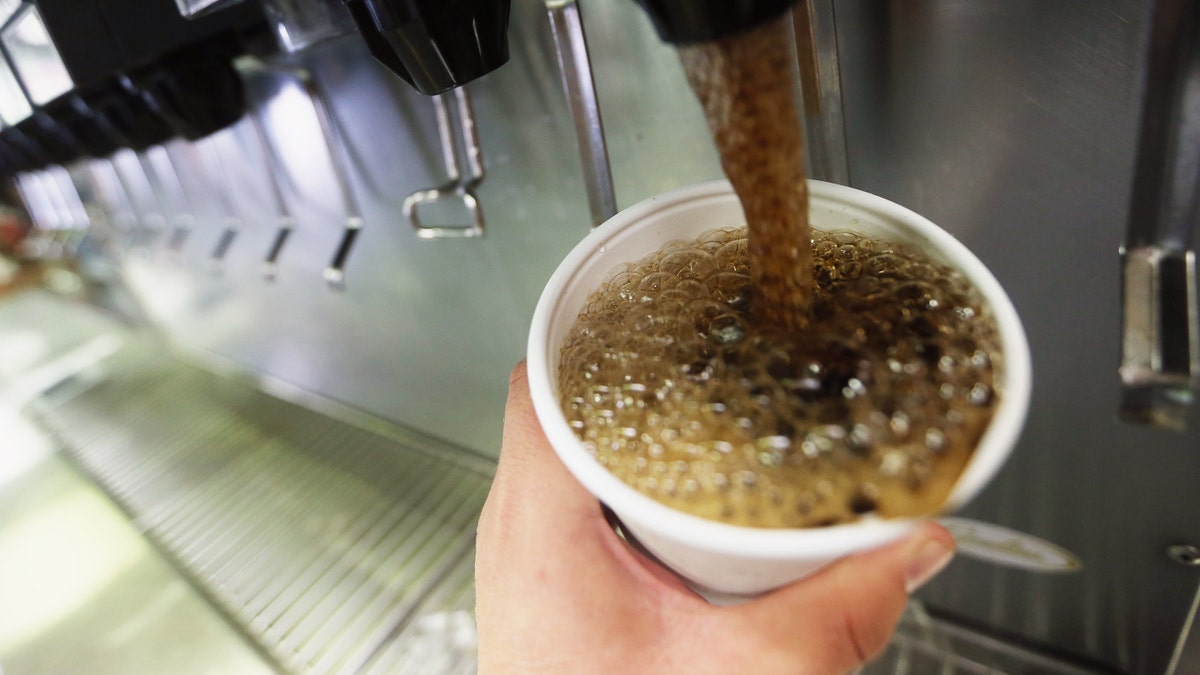
NEW YORK, NY - SEPTEMBER 13: A 32-ounce soda is filled at a Manhattan McDonalds on September 13, 2012 in New York City. In an effort to combat obesity, the New York City Board of Health voted to ban the sale of large sugary drinks. The controversial measure bars the sale of sugar drinks larger than 16 ounces at restaurants and concessions. (Photo Illustration by Mario Tama/Getty Images) (2012 Getty Images)
You run into work with your tall latte in hand. Around mid-morning you pop a vending machine soda. At lunch, you can’t resist a Nestea. The day is only half over and you have already consumed around 400 calories from beverages! That is a 6-oz. lean sirloin steak with 100 calories to spare.
But the main problem is that you do not notice this intake. If you keep a food blog, chances are you never pencil in the Nestea. And experts explain that liquid calories quicken gastric emptying, which decreases satiety, thus caloric intake may increase. In other words, your body does not register the beverage as a solid meal; therefore, the metabolic response is not the same.
And the problem gets worse. Researchers have shown that some beverages can decrease fat oxidation after a meal. So it’s not just the 158 soda calories that went through your stomach and brain unnoticed, but it also slows down fat metabolism.
Certainly, one of the easiest ways to shave off some pounds is to examine your beverage intake. I won’t give you the most common healthy swap suggestions for your high calorie drinks —e.g. swap whole milk for skim. Rather I will analyze which common beverages can either improve or sabotage your weight loss effort.
The Liquids Up and Down
Mooo: Calcium intake has shown to decrease fat storage. However, in a recent study, flavored milk drinkers —250 grams a day— consumed more soft drinks and fruit juices than non-milk consumers throughout the day, thus ingesting more calories overall, says Michael I. McBurney, Ph.D., FACN, in the article “Drink Fluids to Maintain Hydration and Eat to Obtain Calories” published in Nutrition Today. So stay away from flavored milks.
OJ: Having orange juice with a meal may not be friendly for your waist. In a study published in Advances in Nutrition, subjects had breakfast either with orange juice or water. The results showed that resting fat oxidation was significantly lower after the meal with OJ. The researchers explained the caloric beverage not just caused an excess of energy intake, but also limited fat oxidation at rest. While the water group had already metabolized the meal’s fats after 150 minutes, the OJ group did not.
A Cup of Joe: While a cup of coffee 60 minutes prior to a workout can enhance fat mobilization, drink it after a carbohydrates meal —cereal, toast, etc.— and the effect will be canceled. Studies published in the Journal of Medicine & Science in Sports & Exercise, report that caffeine is known for enhancing fatty acid oxidation; however, in the presence of a high carbohydrate meal, the stimulus gets overpowered by the glucose metabolism.
Smoothie Fan: Researchers report satiety may increase when fiber is added to a drink. This was the case when a fiber-rich beverage was given during a meal for seven days; overall energy intake decreased 10 percent at evening, according to results in Advances in Nutrition. However, when comparing “apples with apples,” this is what happened: Apple juice, apple puree, and regular apples were evaluated on satiety and insulin response. As you may expect, insulin response was higher with the liquid and satiety was lower compared to the regular apples. The study authors suggest the removal of fiber from food results in faster and easier ingestion, decreased satiety, and disturbed glucose balance. So if your smoothie includes food rich in fiber, such as apples, oatmeal, etc, you are fine. However, make sure your added fruits are in chunk size. In the same study, the researchers point out that subjects who had a large fruit portion added to their smoothie experienced higher satiety than those with a small fruit portion, even though both beverages had the same calories and nutrients.
Water: You’re drained after your hour workout, so you reach for a sports drink to hydrate. Unless your workout lasted over an hour and/or did it at noon outside in sunny Florida, the sports drink will shut down your fat burnout. Several studies have shown fat oxidation can be around 40 percent greater after water intake than after a caloric beverage. “Decades of crossover experiments consistently demonstrate greater rates of fat oxidation when water is consumed instead of a caloric beverage, before or during low-to-moderate intensity exercise,” says Jody D. Stookey, Ph.D. in his article, “Drinking Water and Weight Management” published in Nutrition Today.
Diet Soda: If you are like me and can’t give up diet soda, it’s time to make a change. After a meal, particularly one high in carbohydrates, insulin release interferes with some of the hormones that promote fat breakdown. Any beverage other than water will affect insulin; thus, the fat oxidation process. The lower the beverage’s glycemic index, the less insulin response, so water is better than milk, milk is better than juices, etc. But aren’t diet sodas calorie-free? Yes, but their sweet taste can stimulate insulin release, which can increase appetite. This also stimulates fat storage and lowers glucose levels, which can lead to sugar crashes and cravings.
